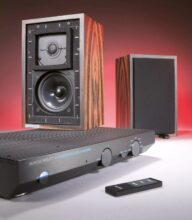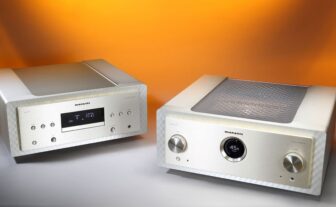Musical Fidelity M8xi Review
The Musical Fidelity M8 Series aims to showcase true state-of-the-art technology. Can the omnipotent M8xi integrated amplifier live up to this claim? Tested at €6999 Euro.
By Thomas Kirsche
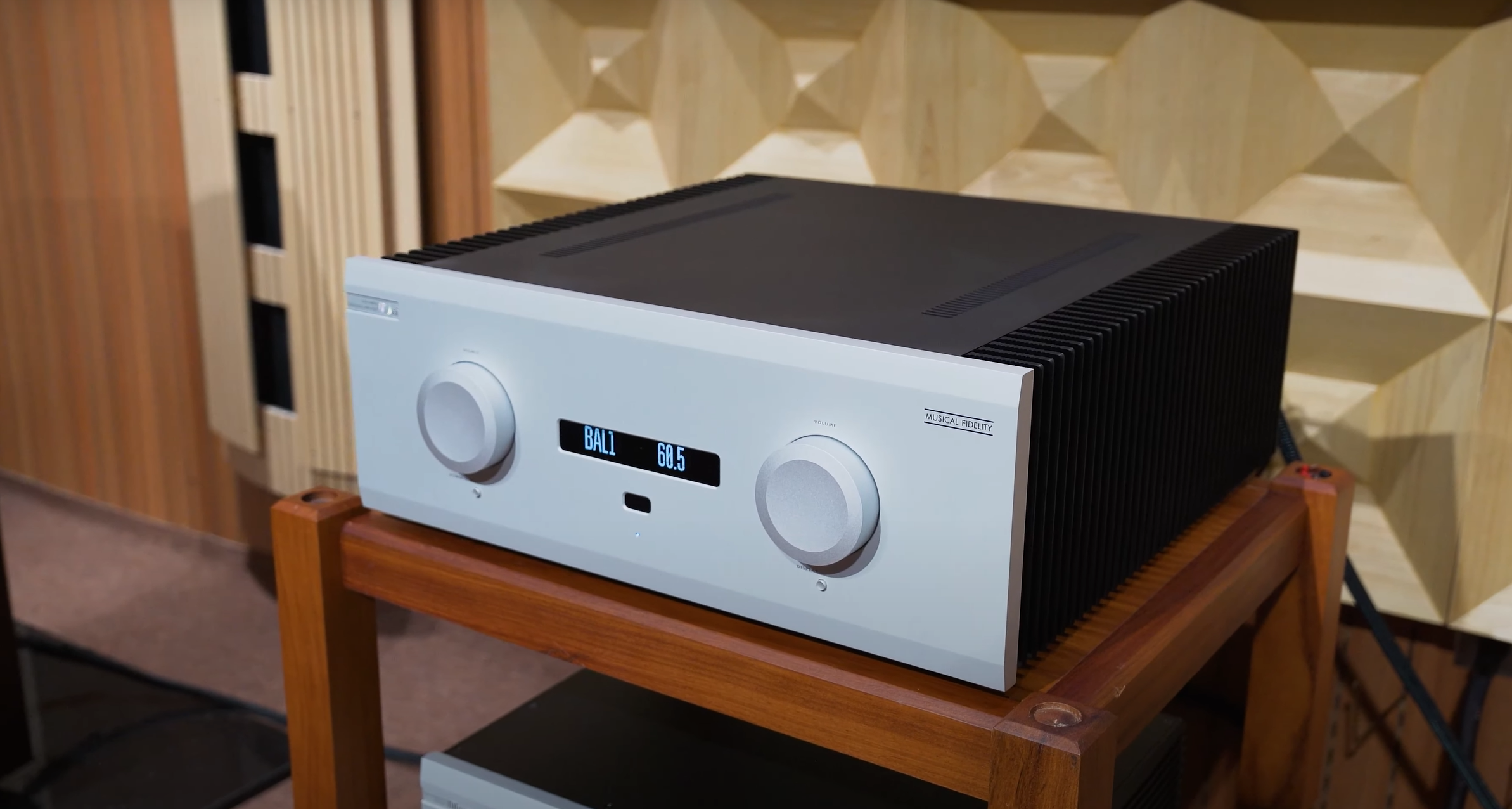
The M8 series, along with the Nu-Vista line, represents the flagship amplifiers from Musical Fidelity. The series is based on the foundational research that led to the Titan series. As a reminder: The Titan is perhaps the most well-known mono power amplifier from Musical Fidelity. It was released in 2008 and, at a “bargain price” of $30,000, delivers 1 kW of power at 8 ohms.
Fifteen years later, it has become an absolute legend in the HiFi world due to its groundbreaking amplifier technology. The Musical Fidelity M8 series is considered the direct successor in terms of components. Therefore, our expectations for the high-end integrated amplifier from Britain are naturally high. But, as often is the case, setup comes before listening.
Installation
The Musical Fidelity M8xi is certainly not a lightweight. The integrated amplifier tips the scales at a staggering 46 kilograms. Those who regularly engage in weight training or are naturally Herculean might be able to handle this weight alone. We are neither, so we carry the M8xi to its place in our test room together.
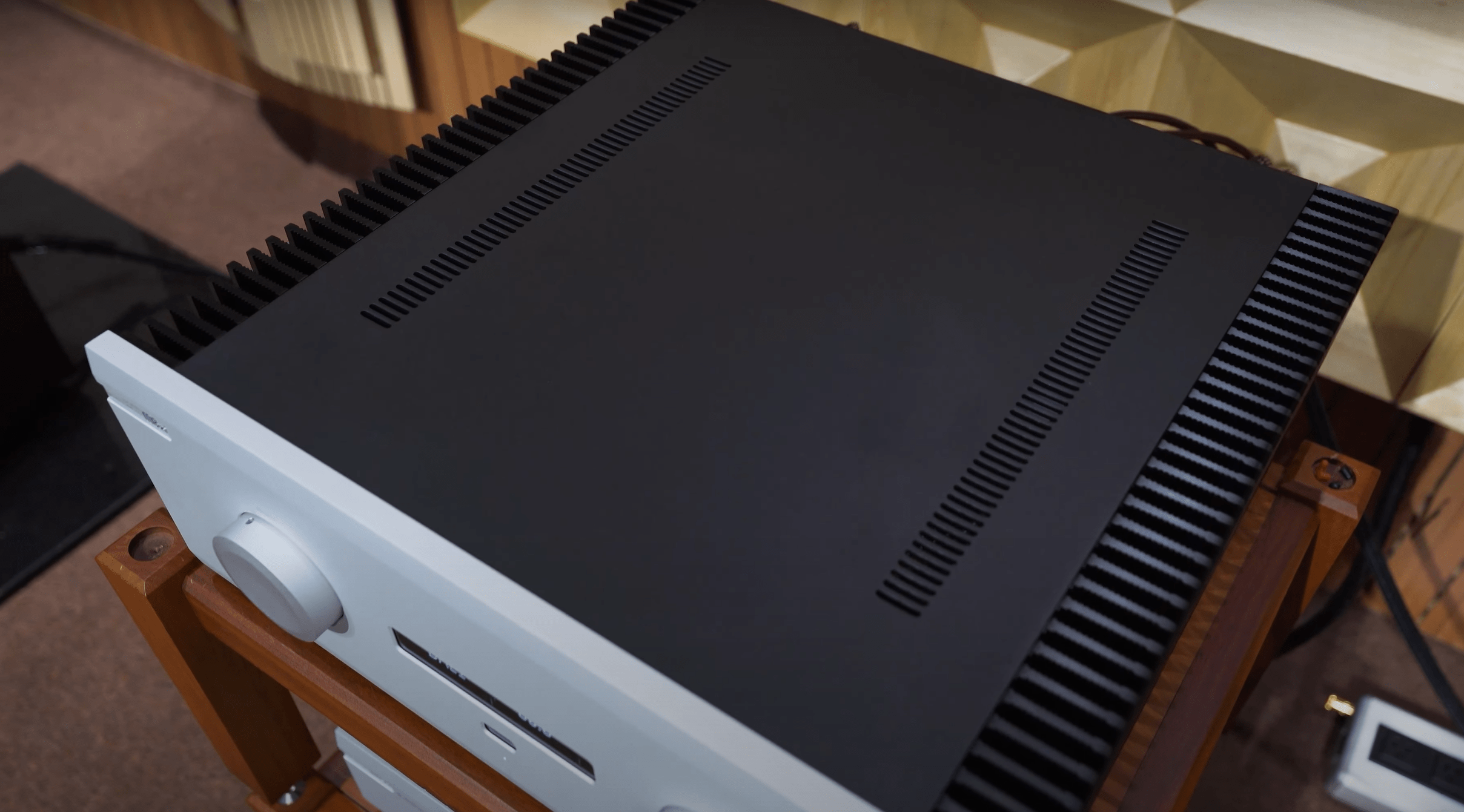
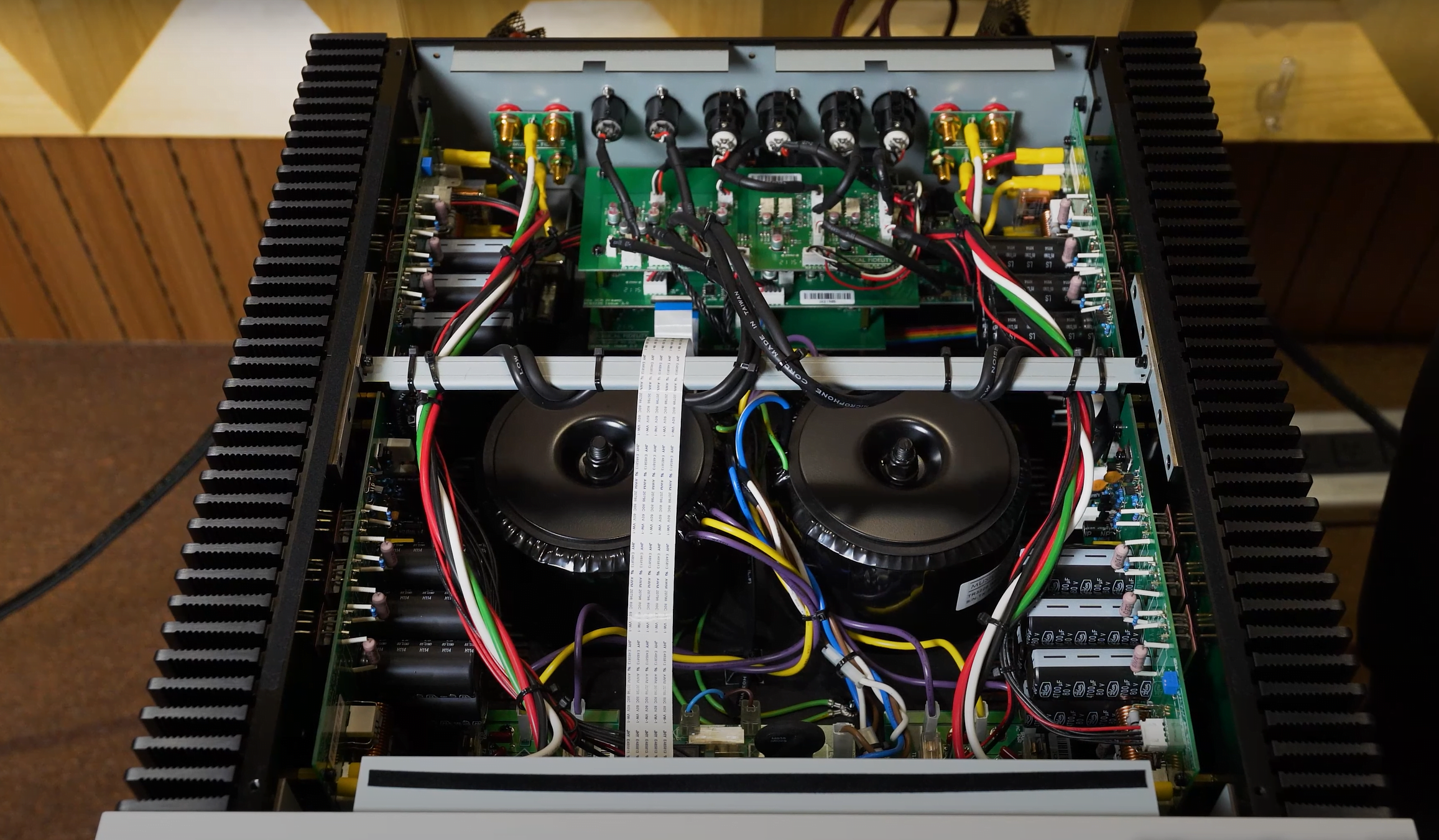
The high weight has a reason. The M8xi is not built as a classic integrated amplifier, where one power supply and transformer supply everything. No, the M8xi was designed in a dual-mono configuration. This means the left and right channels of the power amplifier are driven by separate transformers and power supplies. Effectively, three devices—a preamplifier and two mono power amplifiers—are housed within the unit. The large 48x18x51 cm casing and the extensive heat sinks ensure that these components do not overheat, giving the Musical Fidelity M8xi integrated amplifier its powerful and solid appearance. Naturally, this adds to the weight—and we haven’t even looked at the performance data yet, but we’ll get to that later.
Connectivity
After lifting the Musical Fidelity amplifier into place, it’s time to connect it. And here the M8xi surprises us. We find an abundance of connections. There are two balanced high-level inputs via XLR, three RCA inputs for tuner, CD, etc., and an RCA input that can be used to operate the M8xi directly as a power amplifier. This is relevant, for example, when using it in a home theater system.
Notably, on the back are two pairs of speaker terminals. Initially, we thought these would allow for connecting two separate speaker pairs for an A/B test, but we were wrong! The terminals are actually intended for bi-wiring or for driving four speakers simultaneously. Switching between the two speaker outputs is not possible.
In addition to the analog inputs, there are also digital interfaces. For a Class A or Class AB amplifier, this is not standard, so we are all the more pleased. Among others, we count two coaxial digital inputs with up to 24 bits and 192kHz, as well as two optical inputs with up to 24 bits at 96kHz. The USB-B port also allows up to 24 bits at 192kHz.

These sampling rates and bit depths may not seem particularly high to some digital enthusiasts. Many systems today reach 32 bits and 384kHz, but with D/A converters, it’s less about these numbers and more about the best possible conversion of digital to analog signals. In this regard, the M8xi’s chipset performs outstandingly, proving that raw numbers don’t say anything about the sound.
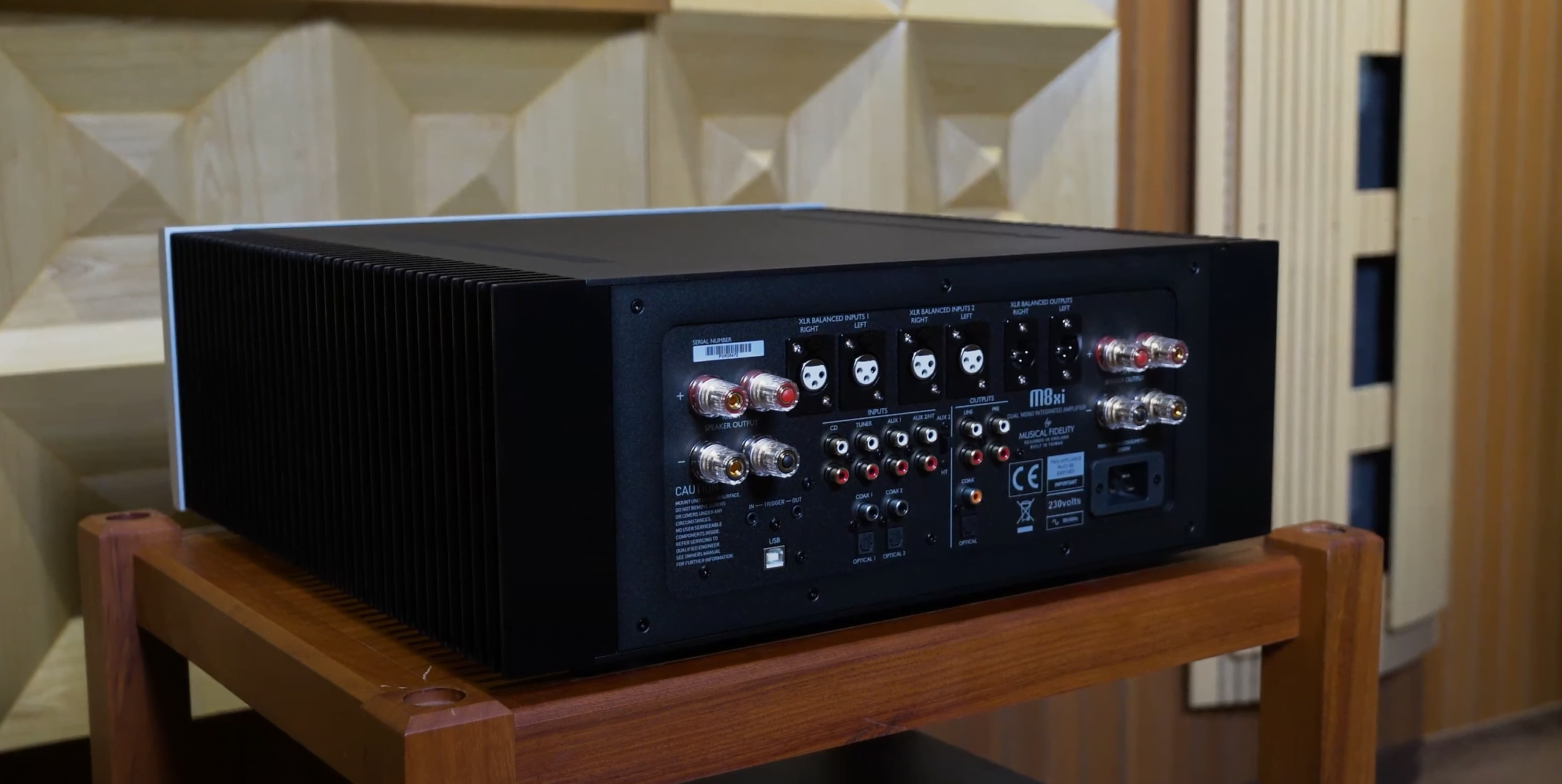
Powerhouse
The preamplifier of the Musical Fidelity M8xi operates as a Class A amplifier and has a completely separate power supply. To ensure the signals of both channels remain low impedance from the moment they enter the amplifier, the connections are directly connected to the mainboard of the preamplifier.
Additionally, the output stage’s power has been increased by about 10% compared to its predecessors while maintaining the same supply voltage. The circuitry, optimized for power and assertiveness, is the reason the amplifier has more “oomph” overall. The preamplifier is indeed responsible for the powerful performance of an integrated amplifier—if it falters here, the power amplifier will never be able to compensate. The two mono blocks of the power amplifier use highly stable bipolar Darlington pairs of transistors, Sanken STD-03N and STD-03P.
These are carefully selected in pairs in an elaborate process to ensure a perfect stereo image. As previously mentioned, each power amplifier channel has its own transformer, which in turn drives a separate power supply. These mono power amplifiers operate according to the Class AB principle, and we can already reveal that they sound like Class A amplifiers.
The output power of the Musical Fidelity M8xi amplifier is 550 watts per channel at 8 ohms, 870 watts at 4 ohms, and even 1,600 watts at 2 ohms. Thanks to the high current output of the M8xi, it can also handle “difficult” speakers. After all, it not only drives the chassis but should also be able to dampen the speaker’s movement. The decay movement of the bass chassis generates voltage through self-induction in the voice coil, which is effectively short-circuited by the amplifier.
This can either be managed by a high damping factor in the amplifier or by high current output. The latter is technically complex and expensive to achieve, but Musical Fidelity has chosen this path with the M8xi to drive very, very demanding speakers from the absolute high-end range. We tested it with the 90,000 Euro speakers Wilson Audio Alexia V, and although one might think it would take at least a 20,000 Euro amplifier to handle these challenging high-end gems, the M8xi mastered them with absolute confidence.
Operation
Control of the integrated amplifier is primarily via the two large, metallic rotary knobs on the front. It’s simply fun to select the volume on the right and the source on the left. We can feel how the electronics behind them play along and translate our inputs precisely. In the center front is the black-and-white display, showing volume and sources. Directly below is the infrared receiver for the remote control. We’ll get to that shortly. The standby switch is located under the left rotary knob for input selection. Unfortunately, there is no power switch on the back, but the M8xi consumes less than 0.5 watts in standby, so that’s acceptable. Let’s talk about the remote control.
This also allows control of CD players from Musical Fidelity, which is why we find more buttons than expected, as the gray buttons are meant for the CD player. What we don’t understand is the absence of a power switch. Yes, if you want to turn off the amplifier, you’ll have to get up from your seat. Additionally, the remote control seems a bit too plain for a 7,000 Euro amp. On the other hand, what use is a fancy remote if the manufacturer skimps on the components of the amplifier? We think it’s better to put the maximum into the device itself rather than into the remote control.

Headphones?
What we miss a little is a headphone jack. However, Musical Fidelity has a very purist view: nothing should be in the amplifier that doesn’t absolutely have to be. And let’s be honest, a true high-end headphone fan would never listen to music through an integrated amplifier anyway, but rather through a dedicated headphone amplifier.
Additionally, there are no controls for balance or bass and treble. But this is also due to the Musical Fidelity philosophy. The amplifier must not interfere with the sound but should reproduce it as it was mixed. Even a balance control would already alter the sound. For example, if we adjust it 10% to the right, the instruments playing on the right would sound louder than intended. Musical Fidelity wants to exclude this from the outset.
The Sound
Now we are, of course, incredibly excited to hear how the Musical Fidelity M8xi sounds in practice. Since we are testing many impressive and very demanding speakers, we can afford to pair the powerful integrated amplifier with several “test objects.”
For example, we have the Wilson Benesch Discovery 3Zero, which can sometimes be a real challenge for “simple” integrated amplifiers. They need to be properly supplied, otherwise, they cannot unleash their full potential. The M8xi ensures exactly that. It extracts a powerful and yet so detailed sound from the Discovery 3Zero that we sit on the sofa, amazed.
Connected to the Raidho X2t floor-standing speakers, this experience is repeated. The bass is simply incredible—the amplifier extracts so much power and dynamics from the Danish speakers.
But that’s not all—paired with the absolute high-end speakers, the Wilson Audio Alexia V, the M8xi, together with these exceptional speakers, creates a complete soundstage. The soundstage is so vividly crafted that one can literally hear the advantages of a dual power amplifier. The sound is bursting with lively details, and we are amazed at the small nuances we discover anew in familiar tracks.
For instance, we experience Stravinsky’s “Firebird” in an entirely new way. Since we can also connect digital sources to the M8xi without any issues, we feed TV sound through an optical cable. We click through various films and series. Again, we are mesmerized by the great channel separation and the power with which the integrated amplifier makes our test room vibrate during explosions and bombastic soundtracks. Then the mood changes in the film, and the Musical Fidelity conjures the subtlest tones into the room in all their finesse. It is a truly remarkable experience.
Finally, we ask ourselves: how will the M8xi perform with speakers that don’t cost over 10,000 euros per pair? The nuVero 140 floor-standing speakers from Nubert are often referred to as “affordable high-end.” With a price tag of just under 4,400 euros, they are among the “more affordable” speakers. Again, we find it incredible how well the M8xi handles the nuVero 140. It reproduces the lively dynamics of the speakers just as well as the high-end speaker models we’ve used in our tests so far. And this proves something important: A good amplifier brings out the best in any speaker, no matter what the price range.
SPECIFICATIONS
General
Device Class: Integrated Stereo Amplifier
Price Category: High-End
Manufacturer: Musical Fidelity
Model: M8xi
Dimensions (W/H/D): 48 x 18 x 51 cm
Weight: 46 kg
Information: www.reichmann-audiosysteme.de
Technical Data (according to the manufacturer)
Power:
550 W/channel (8 Ohms),
870 W/channel (4 Ohms),
1600 W/channel (2 Ohms)
Power Consumption:
Standby: <0.5 W
Operation: max. 2000 W
Inputs:
2x XLR Balanced Line Level, 3x RCA Analog,
1x RCA Analog (Power Amp),
2x RCA/Coax Digital, 2x Toslink/Optical Digital,
1x USB B
Outputs:
2 Pairs of Speaker Terminals (Banana),
1x RCA Fixed Level (Tape Out),
1x RCA Variable Level (Pre Out),
1x XLR Balanced (Pre Out),
1x RCA/Coax Digital,
1x Toslink/Optical Digital,
Trigger (3.5 mm)
Verdict
The M8xi from Musical Fidelity brings out the best in any speaker, whether you’re connecting speakers that cost ten times as much or more affordable models. The power of this amplifier, its dynamic range, and the superb soundstage that reveals the finest details make listening to music a true experience. If you have the opportunity to experience this exceptional amplifier, don’t miss it. You’ll be amazed at how the M8xi carries the music, much like the Titan Atlas once carried the Earth.
FEATURES
- True dual-mono power amplifiers
- Numerous digital and analog inputs
- Class A and Class AB
RATINGS
Sound Quality: 9.9/10
Features/Build Quality: 9.5/10
User-Friendliness: 7.5/10
Adjustments: None
Intermediate Score: 9.6/10
Price/Performance: Excellent 10/10
Final Rating: Reference Class 9.6/10
When you purchase through links on our site, I may earn an affiliate commission. Here’s how it works.
So Macho! Why Musical Fidelity's Massive M8xi Integrated is a Titan Amongst Amplifiers
With well over 500 watts per channel, this is one of the most powerful integrated amplifiers ever made. Yet it's surprisingly ...







